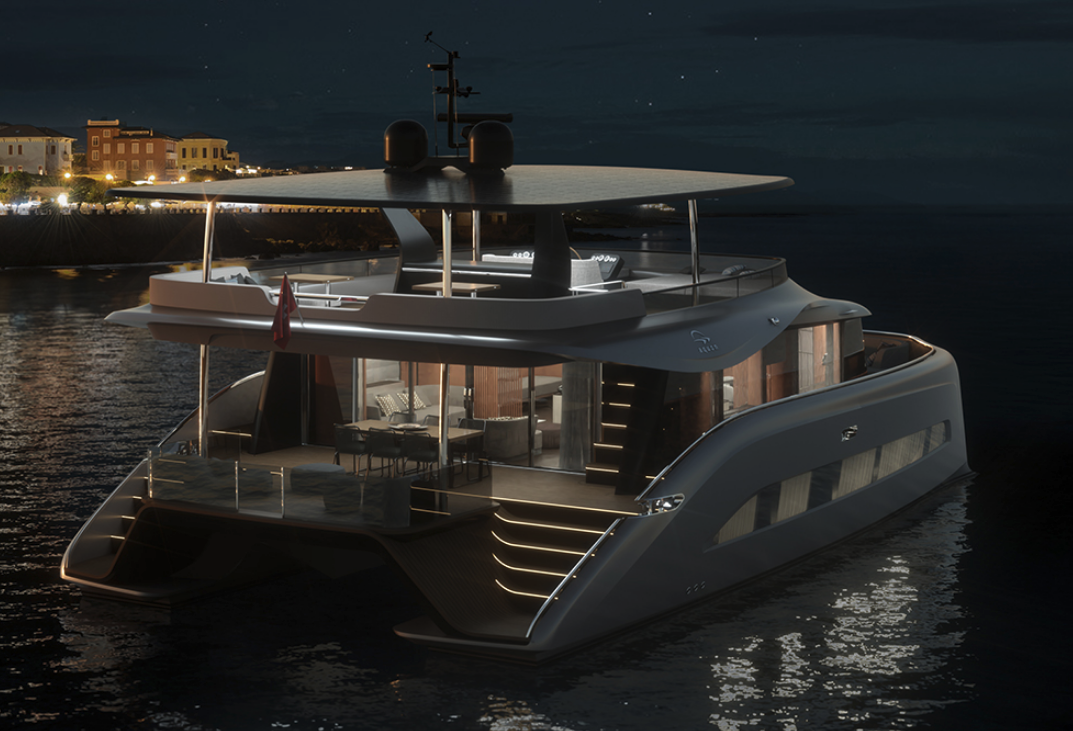Combining two forms of sustainable energy into one range-extending propulsion system, Swiss Sustainable Yachts' clean, quiet catamaran promises to jumpstart a future in which the word "range" becomes obsolete. The 64-footer harnesses solar energy to create its own hydrogen, powering a fuel cell-electric drive to potentially limitless autonomy, so long as the sun is shining and the captain isn't pushing past cruising speed. The Aquon One might prove the ultimate luxury smart yacht of the sustainable generation.
The Aquon One has a 134-hp fuel cell-powered electric engine in each hull. Swiss Sustainable Yachts (SSY) explains that it opts for hydrogen power because of its light weight as compared to batteries or fossil fuels, long-lasting storage capability and lack of harmful emissions. Also critical to the Aquon One design is hydrogen's ability to be created sustainably, in this case using a solar-powered electrolyzer that splits hydrogen from desalinated seawater. The 689 square feet (64 sq m) of solar panels covering the Aquon One's hard-top generate all the electricity needed to develop the hydrogen, which is then stored away in carbon tanks.
The Aquon One does include a small battery bank for short-term energy needs, both for propulsion and onboard electrical usage. The hydrogen, on the other hand, is compressed and designated for longer-term use. SSY claims the hydrogen tanks hold more than 100 times the energy of a full-size modern battery system, offering more range and capability than it would get by expanding the size of its battery.

The idea of relying on sunlight to create electricity, to power hydrogen conversion, to again create electricity for propulsion sounds rather inefficient on its face, and we have doubts as to whether the Aquon One will be able to produce hydrogen as effectively as billed or obtain anything near "limitless" range. That range claim already comes with a big asterisk denoting that "limitless" is only applicable with plenty of sun and the vessel ducking below the 8-knot (15 km/h) cruising speed to stay within 4- to 6-knot (7.4 to 11 km/h) speeds. So even if range is theoretically boundless, it's going to take a while to putter from point A to B – not necessarily a bad thing when aboard a breezy, luxurious 64-foot (19.5 m) catamaran, but still possibly a slower-going trip than desired.
The proposition of an oceangoing yacht that uses readily available solar power to self-sufficiently create its own fuel supply is certainly an attractive one, though. It would be especially useful on an expedition-class yacht meant to explore remote parts of the world, though the Aquon One system clearly isn't advertising unlimited autonomy for that type of usage. The Aquon One is billed more as a short-haul 10-passenger "pocket yacht," and it seems best-suited for the likes of island-hopping, weekend trips and other short excursions.

Solar-hydrogen power isn't the only sustainable component of the Aquon One design. A water recycling system separates gray and black water, purifies and gives the water second life. The construction process relies on sustainable methods and materials, including bamboo. An electric tender ensures that shorter trips are as quiet and emissions-free as the primary vessel.
On board, the Aquon One lives like a smart home of the sea, its 2,691 square feet (250 sq m) of living space tied together by smart energy management, state-of-the-art communications, and a connected appliance suite that includes the fridge, washing machine, dryer, dishwasher and more. Mobile device control makes it easy to increase ventilation, lower or raise window shades, or adjust lighting.

The Aquon One layout starts up high with the wide-open flybridge below the solarized hardtop, hosting an open-air social space with full U-shaped lounge, outdoor kitchen with grill, and bar. The main deck is where passengers will enjoy indoor social spaces, including a living room with large glass windows and its own terrace, a dining area and the main kitchen. The lower deck houses the master and guest bedrooms, bathrooms and crew quarters.
Swiss Sustainable Yachts has been showcasing the Aquon One design at events throughout 2021 and last month partnered exclusively with marine brokerage Fraser Yachts, which lists it at a cool €6 million (approx. US$6.8 million). Latvian shipyard Latitude Yachts will handle construction, and the first deliveries are planned for 2023.
The quick video below provides a closer look at the Aquon One's energy supply.
Source: Swiss Sustainable Yachts AG













